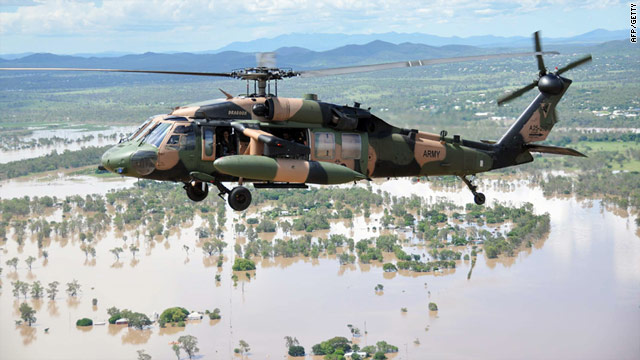Truth Vibrations
New member

-- While floodwaters in Australia have begun to recede in some areas, the worst could still be on the way for at least one city, the country's prime minister said Saturday.
"Today I've been in St. George, and they are still bracing for the peak of the flood," Julia Gillard told Australia's Nine Network, according to a transcript from the prime minister's office. "They're very well prepared, but of course they're anxious as they await the peak."
The seasonal flooding in the state of Queensland intensified last month after monsoon rains caused rivers to spill over their banks and reach record levels.
The floodwaters have covered an area the size of France and Germany combined, stretching from Queensland into the neighboring state of New South Wales, CNN meteorologist Ivan Cabrera said Saturday. Cabrera said the projected rainfall for parts of the two states is expected to be above average through March.
During a press conference Saturday with Queensland Premier Anna Bligh, Gillard said the situation will get tougher for "many, many people" throughout the state of Queensland. She said federal and state officials have made about $4 million in emergency payments to individuals and families.
"Of course, that is the money in the pocket, money on the ground now, but there are hundreds of millions more dollars that are going to be required to help Queensland through and to help with the rebuilding," Gillard said.
Bligh said she was "very heartened" by Australians helping Queensland residents in need. The premier's relief appeal has garnered more than $20 million, Bligh said.
"Twenty million dollars worth of aid over and above the hundreds of millions of dollars that each level of government will be contributing to the rebuilding effort will make a huge (difference), particularly to those families who really have lost everything," she said.
In Rockhampton -- one of the hardest hit cities -- the fast-flowing Fitzroy River was slowly receding after peaking earlier this week at about 9.2 meters (about 30 feet). With many major roads under water, some residents surrounded by the deluge used boats to travel.
Government officials have warned residents to avoid flooded areas, saying some road infrastructure can be dangerous after being flooded for days.
Officials said the degree of damage remained unclear.
"The full extent of the damage to the 33,000 kilometers of state roads is impossible to quantify right now," Craig Wallace, Queensland minister of main roads, said in a statement Friday.
"It will be an unprecedented long-term repair job that will take months, perhaps even years to fully complete," he said.
The flooding also affected about 40 mines in the coal-rich state, the government said in a statement. Environmental officials were monitoring water discharges from the mines, the statement said.
Farmers were particularly hard hit, as water washed over crops and blocked roads used to transport them to market.
Global transport of commodities like coal and steel was also stymied.
Police said 10 people have died as a result of flooding since November 30 -- many of them swept away by swift waters.
The airport in Rockhampton was expected to remain closed for weeks, according to Emergency Management Queensland.
At least 200,000 people have been affected by the prolonged flooding, police have said.
